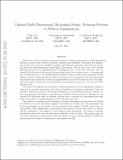Optimal Multi-dimensional Mechanism Design: Reducing Revenue to Welfare Maximization
Author(s)
Cai, Yang; Daskalakis, Konstantinos; Weinberg, Seth Matthew
DownloadDaskalakis_Optimal multi.pdf (421.8Kb)
OPEN_ACCESS_POLICY
Open Access Policy
Creative Commons Attribution-Noncommercial-Share Alike
Terms of use
Metadata
Show full item recordAbstract
We provide a reduction from revenue maximization to welfare maximization in multidimensional Bayesian auctions with arbitrary - possibly combinatorial - feasibility constraints and independent bidders with arbitrary - possibly combinatorial-demand constraints, appropriately extending Myerson's single-dimensional result [21] to this setting. We also show that every feasible Bayesian auction - including in particular the revenue-optimal one - can be implemented as a distribution over virtual VCG allocation rules. A virtual VCG allocation rule has the following simple form: Every bidder's type ti is transformed into a virtual type fi(ti), via a bidder-specific function. Then, the allocation maximizing virtual welfare is chosen. Using this characterization, we show how to find and run the revenue-optimal auction given only black-box access to an implementation of the VCG allocation rule. We generalize this result to arbitrarily correlated bidders, introducing the notion of a second-order VCG allocation rule. Our results are computationally efficient for all multidimensional settings where the bidders are additive, or can be efficiently mapped to be additive, albeit the feasibility and demand constraints may still remain arbitrary combinatorial. In this case, our mechanisms run in time polynomial in the number of items and the total number of bidder types, but not type profiles. This is polynomial in the number of items, the number of bidders, and the cardinality of the support of each bidder's value distribution. For generic correlated distributions, this is the natural description complexity of the problem. The runtime can be further improved to polynomial in only the number of items and the number of bidders in itemsymmetric settings by making use of techniques from [15].
Date issued
2012-10Department
Massachusetts Institute of Technology. Department of Electrical Engineering and Computer ScienceJournal
Proceedings of the 2012 IEEE 53rd Annual Symposium on Foundations of Computer Science
Publisher
Institute of Electrical and Electronics Engineers (IEEE)
Citation
Cai, Yang, Constantinos Daskalakis, and S. Matthew Weinberg. “Optimal Multi-Dimensional Mechanism Design: Reducing Revenue to Welfare Maximization.” 2012 IEEE 53rd Annual Symposium on Foundations of Computer Science (October 2012).
Version: Original manuscript
ISBN
978-0-7695-4874-6
978-1-4673-4383-1
ISSN
0272-5428